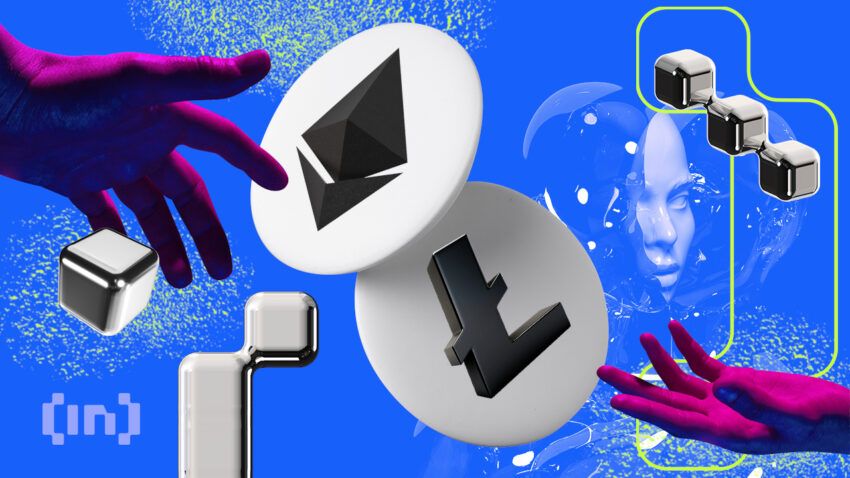Litecoin and Ethereum share common blockchain functionalities but differ significantly in purpose and design. Both networks enable transactions between users, but Ethereum goes a step further by allowing for the creation of decentralized applications (DApps) and smart contracts. Litecoin, on the other hand, offers a low-cost alternative to Bitcoin by facilitating fast, direct peer-to-peer payments. This Litecoin vs. Ethereum guide examines how the two networks differ.
KEY TAKEAWAYS
➤ Litecoin uses proof-of-work and focuses on fast payments; Ethereum uses proof-of-stake, which is a lot more energy efficient.
➤ Ethereum supports smart contracts and DApps; Litecoin primarily facilitates low-cost peer-to-peer transactions.
➤ Ethereum’s transaction costs vary with network demand; Litecoin maintains consistently low transaction fees.
➤ Litecoin offers limited programmability, while Ethereum’s EVM enables complex applications and DeFi solutions.
Litecoin vs. Ethereum: In a nutshell
Before you start checking the details, here is a quick table to help you get started with the Litecoin vs. Ethereum discussion:
| Feature | Litecoin | Ethereum |
| Launch Date | October 7, 2011 | July 30, 2015 |
| Creator | Charlie Lee | Vitalik Buterin |
| Consensus Mechanism | Proof-of-Work (PoW) | Proof-of-Stake (PoS) |
| Transaction Speed | ~2.5 minutes per block | ~15 seconds per block |
| Transaction Cost | ~$0.03-$0.40 | Varies (depends on gas fees) |
| Market Cap | $5.5 billion (as of Oct. 29, 2024) | $320 billion (as of Oct. 29, 2024) |
| Supply Limit | 84 Million | Unlimited (annual cap) |
| Programming Language | C++ | Solidity, Vyper |
| Smart Contract Support | No | Yes |
| DApp and NFT Support | Limited | Extensive |
| Primary Use Case | Peer-to-peer payments | Decentralized applications, smart contracts |
| Decentralization | High | Moderate |
| Energy Efficiency | Lower (due to PoW) | Higher (due to PoS) |
Litecoin vs. Ethereum: what are the differences?
Now, let’s take a closer look at the key aspects that separate the Litecoin and Ethereum networks:
1. Litecoin vs. Ethereum: mechanism
Among all the major differences between the two networks, the most obvious one perhaps is the consensus mechanism. The two popular mechanisms are proof-of-work (PoW) and proof-of-stake (PoS).
Proof-of-work is a mechanism used to decide which nodes (miners) have the right to attach new blocks to a blockchain or validate transactions. It requires users (miners) to dedicate computing power to solving complex mathematical problems to prove that they have done the “work.”
➤ Both Litecoin and Bitcoin rely on the PoW mechanism. In contrast, Ethereum uses proof-of-stake as its Sybil protection mechanism. Proof-of-stake lets users stake their coins or tokens to verify blocks on the blockchain. In doing so, they get rewarded with additional coins proportional to how much they have staked.
Ethereum moved from PoW to a PoS mechanism in September 2022 (termed the Ethereum merge or Ethereum 2.0). The move reduced Ethereum’s energy output by 99.9%, according to reports from ConsenSys. As such, the Ethereum network is cheaper, more scalable, and environmentally friendly than the power-guzzling PoW mechanism used by the Litecoin blockchain.
2. Litecoin vs. Ethereum: programming language and virtual machine
Solidity is the most popular native programming language for the Ethereum blockchain. It was specifically created for constructing and designing smart contracts on blockchain platforms.
It is a high-level language for creating applications on the Ethereum Virtual Machine. Yul is also another programming language native to the Ethereum environment. It is a low-level language.
The Ethereum Virtual Machine (EVM) is a global network of nodes that runs smart contracts on Ethereum. EVM ensures the security and execution of programs through this global network of public nodes, essentially computers running EVM software. The EVM prevents denial-of-service attacks while certifying that programs don’t have access to each other’s state.
On the other hand, Litecoin’s programming language is C++ which is used in many blockchain projects. Note that it does not have a virtual machine, which means that it has limited complexity for programming.
3. Litecoin vs. Ethereum: decentralization
One of the main Litecoin and Ethereum differences is the respective network’s degree of decentralization. The Litecoin network is innately decentralized, maintained by miners who earn Litecoin (LTC) by verifying transactions on the blockchain.
Ethereum, on the other hand, is more centralized than Litecoin. Vitalik Buterin and other developers created it as an alternative to Bitcoin because they wanted to create a platform for decentralized applications (DApps).
Developers and validators still maintain the platform, but there are some differences between them regarding how much power each group has over the platform.
4. Litecoin vs. Ethereum: transaction cost
Transaction costs are one of the most important metrics when choosing any digital currency. Ethereum uses gas to measure the computational effort required to execute transactions.
This is similar to calculating how much gasoline it would take to get a car from one place to another. Users who send Ether tokens pay a gas fee to complete the transaction.
➤ Litecoin users can expect to pay around $0.03 or $0.4 on average transaction fees, while the average Bitcoin transaction fee is around $7.60. This is because Litecoin’s network sets aside LTC that doesn’t derive from transaction fees to incentivize miners, meaning there is less competition for space in blocks than with Bitcoin. The result is lower user fees, making it easier to use as a currency.
Ethereum’s transition to PoS has aimed to make transactions more cost-efficient, but fees remain higher compared to Litecoin
5. Transaction speed: Litecoin vs. Ethereum?
Ethereum features a block time of 15 seconds. In contrast, Litecoin features a block time of 2.5 minutes, with new blocks created after every 2.5 minutes. Multiple transactions can be confirmed every minute on the Litecoin platform.
Compared to Ethereum, Litecoin mining requires mining new blocks, which reduces the transaction speed (by 54 per second), with new blocks created every 2.5 minutes.
6. Litecoin vs. Ethereum: Market cap and coin price
As of Oct. 29, 2024, Litecoin’s market cap is approximately $5.5 billion, with LTC priced around $73.

In contrast, Ethereum’s market cap stands at approximately $319 billion, with ETH priced at around $2,650, at the time of writing.

7. Litecoin vs. Ethereum: DApp and NFT support
When it comes to DApp support, Ethereum remains the leader in this field and is the best blockchain for building a DApp. Despite the growth of multiple competing altchains, most developers still choose to build DApps on Ethereum for all kinds of services.
This includes supply chain management software to increasingly sophisticated DeFi protocols and NFT marketplaces. Litecoin, the digital silver, is primarily a payments coin or a usable digital currency. It makes payments accessible to everyday consumers, making it easier to use crypto for payments at retail stores like Starbucks or Amazon.
Regarding NFTs, Ethereum again leads the pack, with the highest NFT collection market cap of all blockchains (estimated at $3.2 billion, according to CoinGecko data on Oct. 29, 2024). Litecoin also supports NFTs, specifically Ordinals, as of October 2024.
And that wraps up all the differences that matter, between the two largest crypto projects.
What is Litecoin?

Litecoin is a decentralized, open-source cryptocurrency built for peer-to-peer (P2P) transactions. It uses the same codebase as Bitcoin. Charlie Lee, a former Google employee, created the network.
➤ The Litecoin network launched on Oct. 7, 2011. It was originally branded as the digital”silver” to Bitcoin’s digital “gold.” The Litecoin blockchain is based on an open-source protocol that allows anyone to view or modify the code and make their own version.
Litecoin has many similarities to Bitcoin but also has some key differences:
- Transactions are faster, and fees are lower than on the Bitcoin network.
- Litecoin uses a hashing algorithm called Scrypt rather than the SHA-256 encryption algorithms used by Bitcoin. This makes it harder for ASIC hardware manufacturers (like Bitmain) to dominate the mining process.
- Faster block times (2.5 minutes compared to Bitcoin’s 10 minutes), allowing for quicker coin mining.
- Lower transaction fees, averaging around $0.03 to $0.40.
- Litecoin’s supply is capped at 84 million coins, with the current market cap at approximately $5.5 billion as of Oct. 29, 2024.
The Litecoin network aimed to improve Bitcoin’s weaknesses while retaining its strengths. It uses the Lightning Network to facilitate quicker transactions.
What is Ethereum?

Ethereum is a public blockchain with the added feature of a distributed computing machine called the Ethereum Virtual Machine. Unlike Bitcoin and many first-generation blockchains, it is Turing complete.
In layman’s terms, Ethereum has smart contract functionality, which means that you can build applications on it. It was proposed by Vitalik Buterin in late 2013 and went live on July 30, 2015.
➤ Ethereum can tokenize assets, bootstrap, and secure just about anything built on top of it. This includes domain names, voting, financial exchanges, governance, crowdfunding, contracts, or intellectual property.
The Ethereum platform provides developers with tools for building and deploying decentralized applications (DApps). DApps are applications that run on top of Ethereum’s virtual machine (EVM). Users can deploy smart contracts that execute automatically when certain conditions are met.
Ether (ETH) is the native currency of the Ethereum blockchain. People who own ether can send it or “spend” it with other users on the network. This allows them to purchase services and goods from those who accept ether as payment. Ethereum allows developers to create markets where buyers and sellers can transact without needing a third party.
Litecoin and Ethereum: Verdict
Ethereum remains the dominant DeFi protocol and is heavily focused on smart contracts. In contrast, Litecoin, one of the oldest and most established cryptos, is designed to improve upon, but more generally, imitate, Bitcoin. The bottom line in the Litecoin vs. Ethereum battle is that both are well-established crypto networks. Choosing which network and/or crypto you prefer will depend on your activities and goals within the web3 ecosystem.
Frequently asked questions
Which is better crypto, Litecoin or Ethereum?
How does the environmental impact of Litecoin compare to Ethereum?
Can you build and deploy smart contracts on Litecoin like you can on Ethereum?
Disclaimer
In line with the Trust Project guidelines, the educational content on this website is offered in good faith and for general information purposes only. BeInCrypto prioritizes providing high-quality information, taking the time to research and create informative content for readers. While partners may reward the company with commissions for placements in articles, these commissions do not influence the unbiased, honest, and helpful content creation process. Any action taken by the reader based on this information is strictly at their own risk. Please note that our Terms and Conditions, Privacy Policy, and Disclaimers have been updated.





